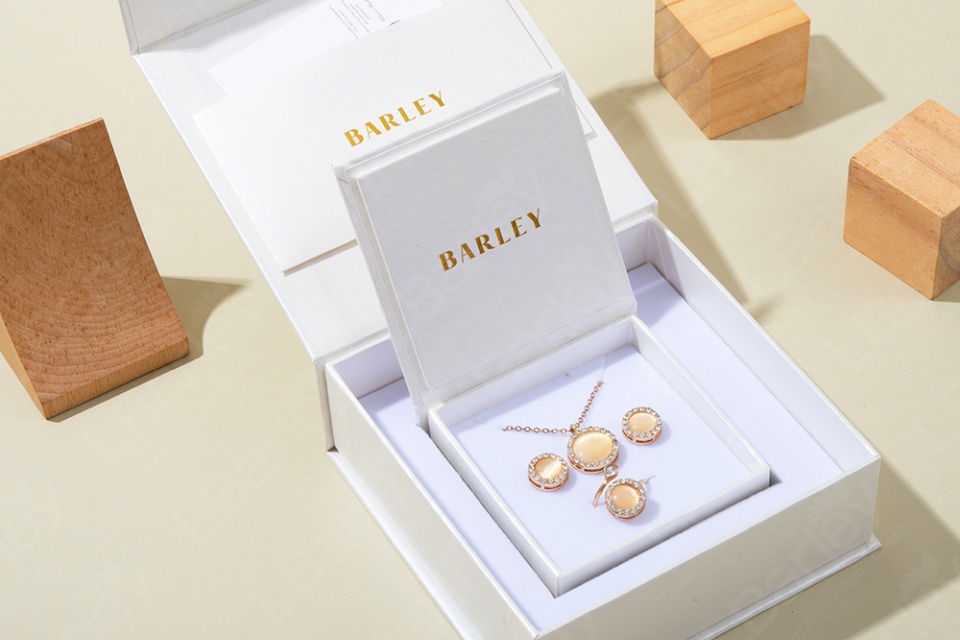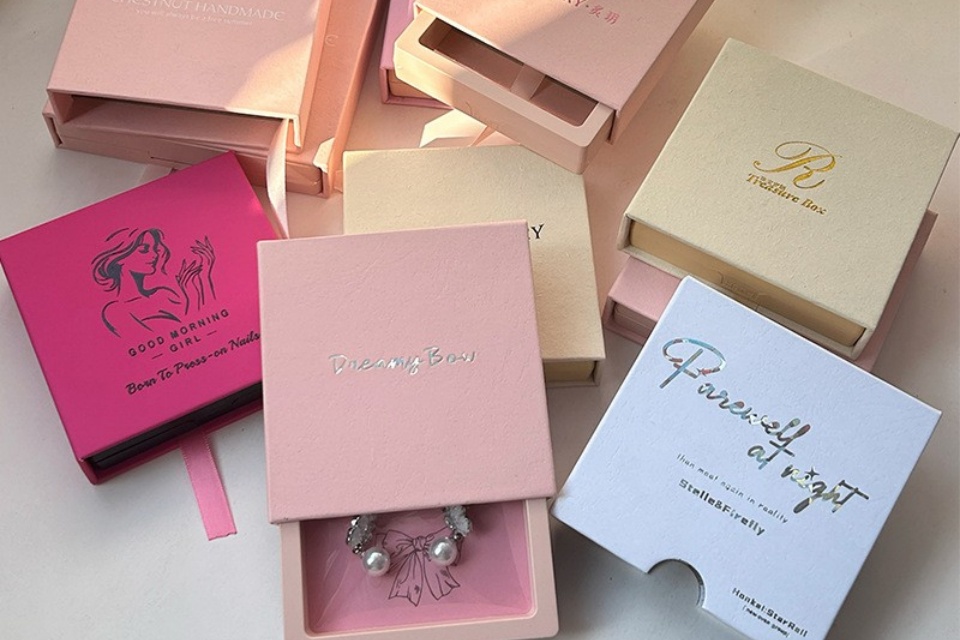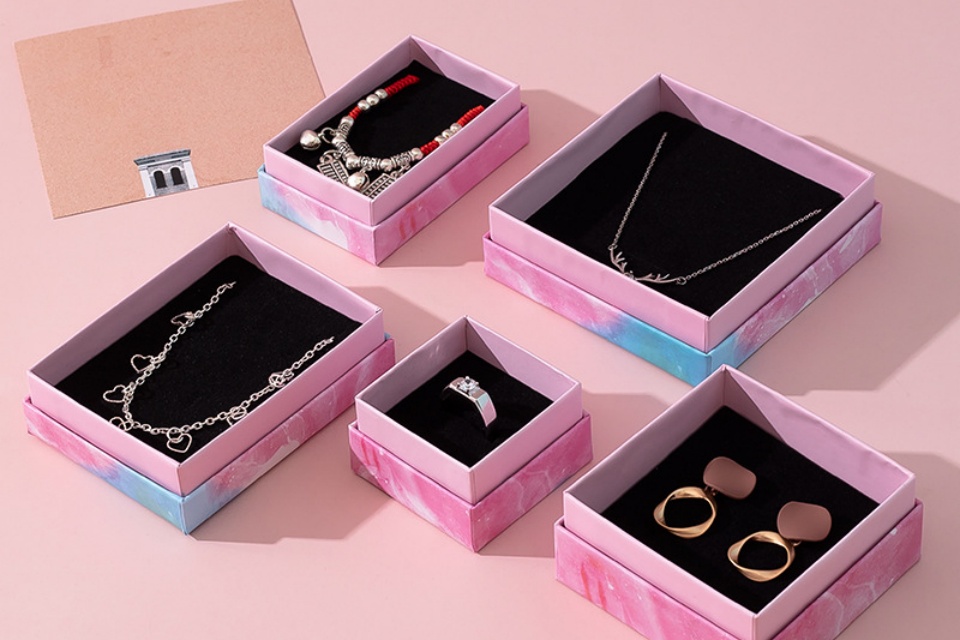Industry News
Custom Jewelry Boxes With Logo Branding
Custom Jewelry Boxes With Logo Branding
Summary
Custom jewelry boxes with logo branding are specialized packaging solutions designed to enhance the presentation and protection of jewelry while simultaneously reinforcing a brand's identity. These boxes have evolved significantly over time, transitioning from basic containers to luxurious and artistic displays that reflect the value of the items they hold. The rising trend of customization in packaging aligns with consumer preferences for personalized experiences, making branded jewelry boxes a notable element in the marketing strategies of jewelry brands today.
The importance of custom jewelry boxes extends beyond mere aesthetics; they play a crucial role in branding and customer engagement. Brands leverage these bespoke boxes to create memorable unboxing experiences, which can foster customer loyalty and encourage repeat purchases. Notably, the use of logo branding on packaging not only ensures instant brand recognition but also communicates the quality and values associated with the brand, such as sustainability and craftsmanship. In an era where consumers increasingly value unique and personalized products, custom jewelry boxes have emerged as a vital tool for differentiation in a competitive market.
Furthermore, contemporary practices in the jewelry packaging industry emphasize sustainability, as brands seek eco-friendly materials that appeal to environmentally conscious consumers. Innovations such as laser engraving and embossing allow for intricate designs that enhance the perceived value of the jewelry while supporting a cohesive brand narrative. However, the integration of sustainability into packaging also presents challenges, as brands must balance cost considerations with consumer demand for eco-friendly options.
Overall, custom jewelry boxes with logo branding represent a convergence of functionality, artistry, and strategic marketing, making them an essential component of the luxury jewelry sector. The ongoing evolution in design preferences, material choices, and consumer expectations highlights the significance of packaging as a key driver of brand identity and customer experience in the modern marketplace.
History
The use of jewelry boxes has evolved significantly over the centuries, transitioning from simple protective cases to intricate pieces that serve as an extension of the jewelry they hold. Initially, jewelry was often stored in basic containers made from available materials. However, as the demand for luxury and aesthetic appeal grew, so did the complexity and artistry of these boxes.
The Evolution of Jewelry Packaging
During the Victorian era, the desire for elaborate design led to the creation of more ornate jewelry boxes, often embellished with carvings, inlays, and luxurious fabrics such as velvet and satin. These designs not only provided functionality but also reflected the opulence of the jewelry contained within, establishing a trend that continues to this day.
In the modern era, brands like Tiffany & Co. and Pandora have taken nostalgia to new heights, intertwining historical references with contemporary aesthetics in their packaging designs. For instance, Tiffany's “Return to Tiffany” collection emphasizes a nostalgic journey, while Pandora's "Timeless” collection captures the essence of retro styles with a modern twist. This blend of old and new showcases how jewelry packaging has become a canvas for storytelling and brand identity.
The Rise of Customization
As consumer preferences shifted towards personalization and uniqueness, the concept of custom jewelry boxes gained traction. Brands began to recognize that personalized packaging not only protects the jewelry but also enhances the overall presentation and customer experience. Custom jewelry boxes with logos and intricate designs serve to strengthen brand recognition and build emotional connections with customers. This movement reflects a broader trend in marketing, where packaging is viewed as an essential aspect of the product itself, contributing to a cohesive brand narrative.
Contemporary Practices
Today, the jewelry packaging industry continues to innovate, incorporating sustainable materials and advanced design techniques. The use of eco-friendly options, such as paper jewelry boxes, caters to the growing demand for sustainable products while maintaining an elegant aesthetic. Furthermore, modern technology allows for more intricate designs, including laser engravings and embossed logos, which elevate the perceived value of the jewelry and enhance the overall brand experience.
As the history of jewelry boxes unfolds, it is clear that they have transitioned from mere storage solutions to vital components of brand identity, reflecting changing consumer preferences and the increasing importance of presentation in the luxury market.
Types of Custom Jewelry Boxes
Custom jewelry boxes come in various styles and materials, allowing for personalization and branding that cater to different jewelry types and customer preferences.
Styles of Jewelry Boxes
Rigid and Hinged Boxes
Rigid boxes provide a sturdy option for packaging jewelry, often featuring a hinged lid that opens to reveal the contents inside. These boxes can be customized with logo embossing, foil stamping, and other design elements to enhance their aesthetic appeal and align with brand identity.
Drawer-Style and Magnetic Closure Boxes
Drawer-style boxes offer a unique way to present jewelry by pulling out a drawer to reveal the items, while magnetic closure boxes combine convenience and elegance with a secure yet easy-open mechanism. Both styles are popular for their practicality and style, making them ideal for various types of jewelry, including rings and necklaces.
Luxury Fabric Boxes
Jewelry boxes made from luxurious fabrics such as silk, velvet, and leatherette are increasingly popular. These soft-textured boxes not only provide a premium feel but also protect delicate items inside. Embroidered silk boxes, for instance, combine opulence with personal touches like monogramming, appealing to high-end consumers.
Materials Used in Jewelry Boxes
Wood and Natural Materials
Wooden jewelry boxes, crafted from attractive woods like mahogany, cedar, and walnut, provide a classic and sophisticated look. Bamboo and cork are also emerging as sustainable choices, appreciated for their unique textures and eco-friendly properties. These materials cater to consumers seeking both elegance and environmental consciousness.
Eco-Friendly Options
Recycled paper, linen, and plant fibers are gaining traction in the packaging industry as environmentally friendly alternatives. These materials are durable, recyclable, and appeal to consumers looking for sustainable choices, reflecting a growing trend towards eco-conscious packaging.
Metal and Foil Finishes
Boxes featuring metallic finishes are created from metalized paper or cardstock, often enhanced with foil stamping. This adds a touch of sophistication and can create striking visual effects, making these boxes stand out in retail displays.
Customization Features
Custom jewelry boxes can be personalized with various features to enhance their functionality and visual appeal.
- Cushioning Inserts: Soft padding helps protect delicate items and enhances the presentation.
- Embossing and Debossing: Techniques used to create raised or recessed designs, such as logos, enhancing the tactile experience.
- High-Quality Printing: Options for bleached or unbleached paper, depending on desired aesthetics and sustainability goals.
Logo Branding
Custom jewelry packaging serves not only to protect the items inside but also to enhance brand identity through effective logo branding. Incorporating logos, engraved initials, meaningful dates, and taglines into jewelry packaging creates a bespoke experience that resonates with consumers and reflects the brand's essence. A well-placed logo, whether embossed, printed, or featured as a hangtag, ensures instant brand recognition, helping customers identify and connect with the brand.
Brand Elements
The fundamental elements of branding within jewelry packaging include logo placement, brand colors, and messaging. The logo should be prominently displayed to enhance visibility and recognition, while the choice of colors should align with the brand's personality; soft pastels may evoke delicacy, whereas bold metallic tones can represent luxury or edginess. Additionally, incorporating a brief brand message that highlights core values—such as sustainability or handcrafted quality-can create a deeper emotional connection with consumers.
Consistency and Materials
Consistency across all packaging materials is vital. Utilizing the same fonts, colors, and logo placements across boxes, pouches, and tags ensures a unified brand identity that strengthens recognition. The selection of materials is equally important; luxurious textures such as velvet or silk not only enhance the aesthetic appeal but also elevate the customer experience, making them feel valued from the moment they receive their purchase.
Techniques for Logo Enhancement
Various printing techniques, including hot stamping, embossing, and debossing, can be employed to enhance the logo's visual impact. Embossing creates a raised effect that adds depth and sophistication, while debossing provides a neat, understated appearance. Combining these techniques with foil stamping or spot UV can create packaging that stands out, providing a tactile experience that leaves a lasting impression on consumers.
Benefits of Custom Jewelry Boxes
Custom jewelry boxes offer a range of benefits for both brands and consumers, enhancing the overall jewelry buying experience. These boxes are more than just functional packaging; they serve as a powerful marketing tool that can elevate a brand's image and strengthen customer relationships.
Enhancing Brand Image
One of the primary advantages of custom jewelry boxes is their ability to enhance a brand's image. Exquisite packaging reflects the brand's commitment to quality and attention to detail, leaving a lasting impression on consumers. When designed thoughtfully, these boxes convey professionalism and create a high-end perception of the products inside. This not only attracts customers but also fosters brand loyalty by making consumers feel valued.
Uniqueness and Personalization
Customized jewelry boxes provide a unique touch that sets products apart from competitors. Consumers increasingly seek personalized experiences, and custom packaging that matches the specific jewelry piece enhances its perceived value. By offering distinctive designs that resonate with individual tastes, brands can create memorable unboxing experiences that encourage repeat purchases.
Improved Protection
Custom jewelry boxes are specifically designed to offer optimal protection for delicate items. Made from durable materials, these boxes safeguard jewelry from dust, moisture, and potential damage during transport and storage. With features like cushioned inserts, they prevent scratches and maintain the integrity of the jewelry, which is crucial for maintaining customer satisfaction and trust.
Elevating the Purchasing Experience
The unboxing experience plays a significant role in consumer satisfaction. A well-crafted custom box can enhance anticipation and excitement when purchasing jewelry, transforming a simple transaction into a special occasion. By incorporating premium finishes and thoughtful design elements, brands can elevate the overall purchasing experience, encouraging customers to share their positive experiences online, leading to free marketing.
Strengthening Customer Loyalty
Investing in high-quality, unique packaging strengthens customer loyalty and enhances brand recognition. When consumers receive a beautifully packaged item, it reinforces their perception of quality and care, making them more likely to return for future purchases. Personal touches, such as handwritten notes or tailored packaging, can further deepen this connection and create advocates for the brand.
Practical Considerations
In addition to their aesthetic appeal, custom jewelry boxes are designed with functionality in mind. They can include various compartments to organize jewelry, preventing tangles and misplacements. The use of high-quality materials, such as wood or leather, not only enhances visual appeal but also communicates a message about the brand's dedication to quality before the box is even opened.
Design and Customization Preferences
Customization plays a pivotal role in the jewelry packaging industry, emerging as a top trend for 2023 and 2024. Brands are increasingly focusing on unique and memorable packaging designs to capture consumer interest and enhance brand loyalty. Options for personalization, such as custom engraving or monogramming, allow customers to add a personal touch to their jewelry boxes, catering to the growing demand for bespoke experiences. A 2023 study by Luxury Brand Insider revealed that 75% of luxury buyers prioritize personalization in their purchases.
Sustainability and Material Choices
Modern consumers are also leaning towards sustainable packaging solutions. In fact, over 55% of consumers express a willingness to pay a premium for sustainable products, highlighting the importance of eco-friendly practices in packaging design. Utilizing biodegradable plastics, recycled paper, and metal materials can resonate well with environmentally conscious customers. Effective communication of these sustainable features, including certifications and transparent material sourcing, can significantly enhance consumer trust and appeal.
Trends in Aesthetics
Jewelry box designs can be categorized into two main styles: minimalist and ornate patterns. Minimalist designs feature clean lines and understated textures, creating a sophisticated appearance. For instance, a debossed logo on a matte black box can direct focus to the brand name while maintaining a subtle elegance. On the other hand, ornate patterns typically include intricate details and textures that convey luxury and high-end appeal, such as multi-level embossed designs.
Incorporating elements like embossing or debossing into packaging can elevate the overall perception of the product. However, designers should maintain appropriate clearances from physical edges and folds to ensure structural integrity and visual clarity.
Functional and Practical Aspects
The functionality of jewelry packaging is equally important. Many consumers prioritize packaging that not only looks good but also serves practical purposes, such as organized compartments for different types of jewelry. For instance, travel jewelry cases with integrated mirrors and designated slots for rings and necklaces can enhance user experience, ensuring that jewelry is easily accessible and neatly arranged.
By aligning design strategies with consumer preferences for personalization, sustainability, and functionality, jewelry brands can effectively create packaging solutions that meet the evolving demands of the market, fostering a deeper connection with their customers.
Cost Considerations and Strategies
When it comes to custom jewelry packaging, understanding the full financial implications is crucial for brands looking to optimize their expenditures. A key concept to grasp is the Total Cost of Ownership (TCO), which takes into account not just the upfront costs of materials but also the long-term expenses associated with maintenance and durability of the packaging. This approach can help brands choose between options with lower initial prices and those that may require higher investment but offer greater longevity and reduced upkeep costs.
Bulk Purchasing and Cost Efficiency
One effective strategy for reducing packaging costs is to purchase materials in bulk. Buying larger quantities can significantly decrease the price per unit, allowing brands to maintain high-quality standards while cutting down on expenses. Additionally, selecting designs that can be used across multiple product lines can eliminate the need for individualized packaging, further enhancing cost efficiency.
Budgeting and Quality Balance
Establishing a budget is essential for any business. Brands should prioritize their spending based on their specific needs; for instance, if branding is a top concern, investing in high-quality materials for visible parts of the packaging—such as embossed logos—can yield long-term benefits. Conversely, less visible elements may utilize more economical materials to maintain overall budgetary constraints without compromising brand integrity.
Design Simplification
The design of the packaging can have a significant impact on production costs. By simplifying the structure and minimizing unnecessary decorations, brands can effectively control these costs. For example, using a foldable design not only facilitates easier storage and transportation but also helps in reducing material waste during production. This balance of simplicity and aesthetic appeal can enhance both consumer experience and cost management.
Prototyping and Quality Control
Before committing to mass production, it is advisable for brands to create prototypes of their packaging. Prototyping allows for early detection of potential flaws, saving time and money in the long run. A robust quality control process should also be in place to ensure that materials and final products meet the expected standards, thereby avoiding additional costs related to defects or customer dissatisfaction.
Personalized Packaging Options
Investing in personalized packaging can enhance customer perceptions and brand loyalty. Customization options such as engraving or unique finishes can elevate the unboxing experience and make the products feel more premium, even if they are affordably priced. These personalization strategies not only add value to the product but also align with consumer expectations for quality and uniqueness, which can justify higher price points in the market.
Categories
Latest News
Contact Us
Contact: Aaron Lee
Phone: +8613570866244
Tel: +8675529490260
Add: Li Songlang 2nd Industrial Zone,No.18,FengTang Rd,Guangming New District


